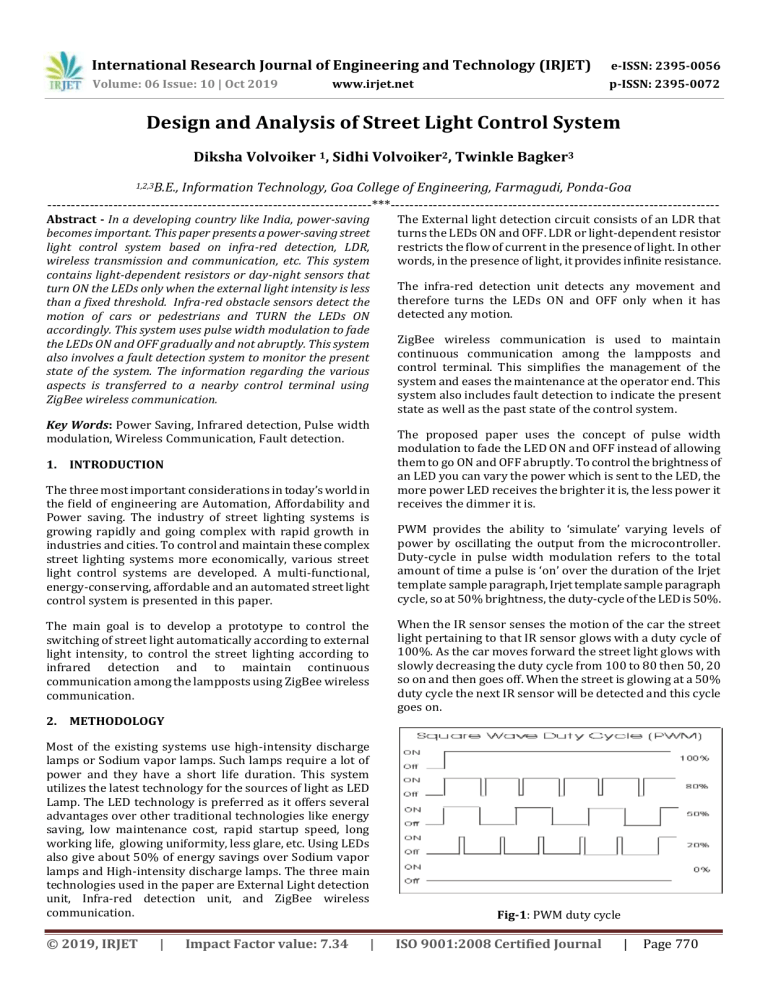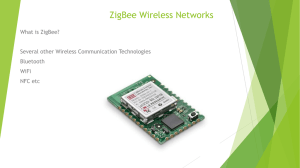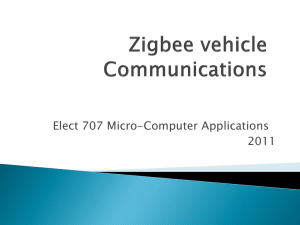IRJET-Design and Analysis of Street Light Control System

International Research Journal of Engineering and Technology (IRJET)
e-ISSN: 2395-0056
Volume: 06 Issue: 10 | Oct 2019 www.irjet.net p-ISSN: 2395-0072
Design and Analysis of Street Light Control System
Diksha Volvoiker
1
, Sidhi Volvoiker
2
, Twinkle Bagker
3
1,2,3
B.E., Information Technology, Goa College of Engineering, Farmagudi, Ponda-Goa
---------------------------------------------------------------------***----------------------------------------------------------------------
Abstract In a developing country like India, power-saving becomes important. This paper presents a power-saving street light control system based on infra-red detection, LDR, wireless transmission and communication, etc. This system contains light-dependent resistors or day-night sensors that turn ON the LEDs only when the external light intensity is less than a fixed threshold. Infra-red obstacle sensors detect the motion of cars or pedestrians and TURN the LEDs ON accordingly. This system uses pulse width modulation to fade the LEDs ON and OFF gradually and not abruptly. This system also involves a fault detection system to monitor the present state of the system. The information regarding the various aspects is transferred to a nearby control terminal using
ZigBee wireless communication.
The External light detection circuit consists of an LDR that turns the LEDs ON and OFF. LDR or light-dependent resistor restricts the flow of current in the presence of light. In other words, in the presence of light, it provides infinite resistance.
The infra-red detection unit detects any movement and therefore turns the LEDs ON and OFF only when it has detected any motion.
ZigBee wireless communication is used to maintain continuous communication among the lampposts and control terminal. This simplifies the management of the system and eases the maintenance at the operator end. This system also includes fault detection to indicate the present state as well as the past state of the control system.
Key Words : Power Saving, Infrared detection, Pulse width modulation, Wireless Communication, Fault detection.
1.
INTRODUCTION
The proposed paper uses the concept of pulse width modulation to fade the LED ON and OFF instead of allowing them to go ON and OFF abruptly. To control the brightness of an LED you can vary the power which is sent to the LED, the more power LED receives the brighter it is, the less power it receives the dimmer it is.
The three most important considerations in today’s world in the field of engineering are Automation, Affordability and
Power saving. The industry of street lighting systems is growing rapidly and going complex with rapid growth in industries and cities. To control and maintain these complex street lighting systems more economically, various street light control systems are developed. A multi-functional, energy-conserving, affordable and an automated street light control system is presented in this paper.
PWM provides the ability to ‘simulate’ varying levels of power by oscillating the output from the microcontroller.
Duty-cycle in pulse width modulation refers to the total amount of time a pulse is ‘on’ over the duration of the Irjet template sample paragraph, Irjet template sample paragraph cycle, so at 50% brightness, the duty-cycle of the LED is 50%.
The main goal is to develop a prototype to control the switching of street light automatically according to external light intensity, to control the street lighting according to infrared detection and to maintain continuous communication among the lampposts using ZigBee wireless communication.
2.
METHODOLOGY
When the IR sensor senses the motion of the car the street light pertaining to that IR sensor glows with a duty cycle of
100%. As the car moves forward the street light glows with slowly decreasing the duty cycle from 100 to 80 then 50, 20 so on and then goes off. When the street is glowing at a 50% duty cycle the next IR sensor will be detected and this cycle goes on.
Most of the existing systems use high-intensity discharge lamps or Sodium vapor lamps. Such lamps require a lot of power and they have a short life duration. This system utilizes the latest technology for the sources of light as LED
Lamp. The LED technology is preferred as it offers several advantages over other traditional technologies like energy saving, low maintenance cost, rapid startup speed, long working life, glowing uniformity, less glare, etc. Using LEDs also give about 50% of energy savings over Sodium vapor lamps and High-intensity discharge lamps. The three main technologies used in the paper are External Light detection unit, Infra-red detection unit, and ZigBee wireless communication. Fig-1 : PWM duty cycle
© 2019, IRJET | Impact Factor value: 7.34 | ISO 9001:2008 Certified Journal | Page 770
International Research Journal of Engineering and Technology (IRJET)
e-ISSN: 2395-0056
Volume: 06 Issue: 10 | Oct 2019 www.irjet.net p-ISSN: 2395-0072
Fig-4 : Fault detection scenario 1
The above snapshot checks LED 1 for any faults. Since IR 1 is high, LED 1 should have been high. Therefore LED 1 is declared faulty with probable causes for it.
Fig-2: Transmitting end
The transmitter end consists of power supply, microcontroller Genuino Mega 2560, LDR, IR sensors, ZigBee
Series S2 transmitter module and LED lampposts.
The operating voltage for the ZigBee transmitter and receiver pair is 3.3 V.
ZIGBEE RECEIVING
MODULE RX
CONTROL TERMINAL
Fig-3: Receiving end
Fig-5 : Fault detection scenario 2
The lifespan of LED 1 is checked to see whether its lifespan has expired.
The receiver part consists of the ZigBee receiver module
Series S2 and the control terminal (PC).
The power supply provides 5V regulated supply to the microcontroller, IR sensors, and LDR. The ZigBee transmission module transmits the information from the microcontroller about the status of IR sensors and LEDs to the ZigBee receiver module. This information received from the Zigbee receiver module is saved in a database and later used for fault detection. The concept of pulse width modulation is used to fade the LEDs ON or OFF gradually giving a fading effect. The brain of the system is
Microcontroller Genuino Mega 2560 which has 54 digital input/output pins (of which 15 can be used as PWM outputs), 16 Analog inputs, 4 UARTs (hardware serial ports), a 16 MHz crystal oscillator, a USB connection, a power jack, an ICSP header, and a reset button.
Fig-6 : Fault detection scenario 3
The above snapshot checks for the lifespan of IR sensor 1 and shows that IR1 has 22 days until its expiry.
3. RESULT
3.
CONCLUSION
GUI at the control terminal that shows the current state of the system as well performs fault detection is developed as a
Visual C# Windows Forms Application.
This paper presents a reliable, energy-saving, automated street light control system model with the least manual work that is extendable according to user needs. The solution can be used primarily in areas where there is less traffic density and during the wee hours of the night. The proposed system uses a power-saving mechanism for street lights by using
LED lamps as a replacement of normal lamps and using
© 2019, IRJET | Impact Factor value: 7.34 | ISO 9001:2008 Certified Journal | Page 771
International Research Journal of Engineering and Technology (IRJET)
e-ISSN: 2395-0056
Volume: 06 Issue: 10 | Oct 2019 www.irjet.net p-ISSN: 2395-0072 special power savings mechanisms for microcontroller and
ZigBee modules.
4.
FUTURE SCOPE
Solar panels can be used for further energy savings and the entire system can be made dependant on solar energy. GSM module also can be used along with solar panels to automate the proposed system further by providing the required information through SMS form to people that are required to maintain street lights. Android app can be developed to provide useful and timely notifications to people at the control terminal.
REFERENCES
[1]. Design of Traffic Flow-based Street Light Control
System
Vipasha Centre for Development of Advanced Computing,
Mohali, Punjab, India & Preeti Abrol Centre for Development of Advanced Computing, Mohali, Punjab, India
[2] . Design and Implementation of an Automatic Street
Light Control System
Isah Abdulazeez Watson, Oshomah Abdulai Braimah,
Alexander Omoregie (Department of Electrical/Electronic
Engineering, Auchi Polytechnic, Auchi, Nigeria)
[3]. A Prediction System Based on Fuzzy Logic
Vaidehi .V, Monica .S , Mohamed Sheik Safeer .S, Deepika .M4,
Sangeetha .S
[4]. GSM based RFID approach to the automatic street lighting system
Shilpashree R N, Shruthi H, Smitha S, Veenashree C N,
Arpitha Shankar
[5]. Street light glow on detecting vehicle movement
S. Suganya1, R. Sinduja, T. Sowmiya & S. Senthilkumar
[6]. Lighting the clean revolution.
Finding of a study
© 2019, IRJET | Impact Factor value: 7.34 | ISO 9001:2008 Certified Journal | Page 772






